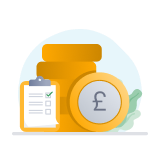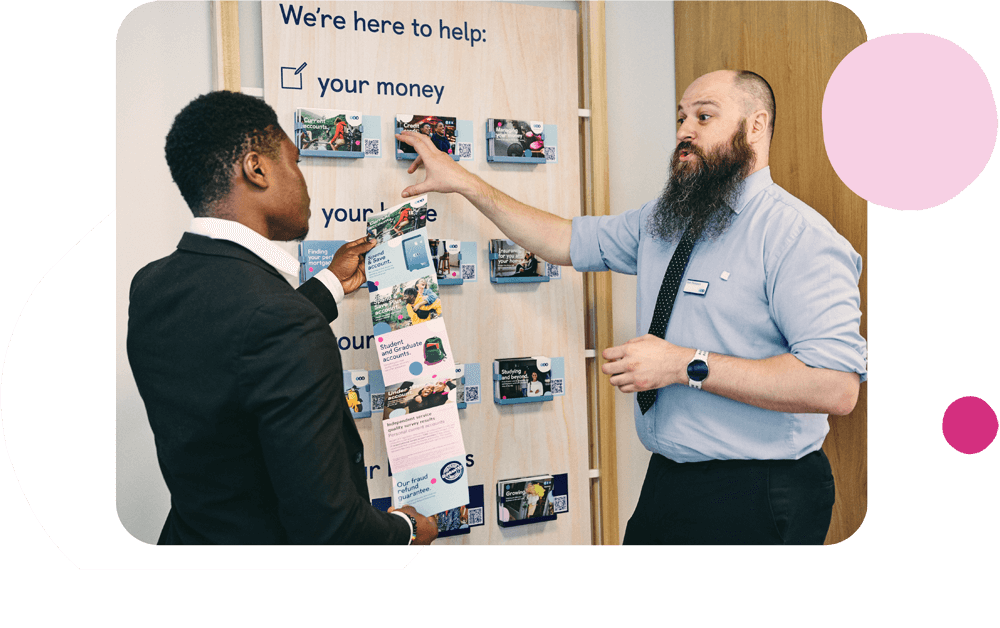Together we can end domestic abuse.

Understanding Debt Repayment Methods
If you're struggling with debt, you're not alone, and you don't have to figure it out on your own either. Speaking to a debt adviser can open your eyes to more options than you might expect. Charities like StepChange can help, and so can your lender.
In this blog, we’ll explain a couple of methods that could be used to help manage debt: the Snowball and Avalanche methods. Both are effective strategies — but what matters most is finding the right approach for you, with the right support along the way.
At TSB, we're here to help. If you're feeling overwhelmed, the most important step you can take is to speak to your creditor - whether that’s us or someone else. Every lender, including TSB, has support available.
Reaching out might feel difficult—but it’s the best thing you can do. Help is available and taking that first step puts you back in control.

Practical steps to get started with debt repayment
Getting started with debt repayment can feel daunting. But with a clear plan and a bit of support, you can take confident steps forward and start chipping away at your balances.
- Make a List of Your Debts
Write down everything you owe - including credit cards, loans, overdrafts, and other obligations - and organise them. This could be based on balance or interest rate, or you might prefer another method—like the number of years remaining if it's a loan.
- Evaluate Your Budget
Start by mapping out your priority payments first: we’re talking your mortgage, utility bills, and food shopping. With essentials set aside, review your other monthly income and outgoings to see where you can free up any extra funds to put toward your repayments. Even the smallest savings here and there add up.
TSB Spend and Save customers can use the TSB Mobile Banking App to create Savings Pots. Find out more.
- Choose Your Repayment Method
Now it’s time to choose the debt repayment method that feels right for you. Think about your goals and what will keep you on track: Snowball is great for quick wins and staying motivated - this method starts with paying off the smallest debts first, while the Avalanche method is perfect if you want to save more in the long run and don’t mind slower progress - this is where you start to pay off the larger debts first. It is important with any method you choose not to miss the minimum payments due on any debt.
If you’re juggling multiple high-interest debts, why not consider consolidating them into one loan so they’re easier to manage? Find out more with our guide to debt consolidation and speak to your lender.
- Set Realistic Payment Goals
Set clear, realistic goals for yourself, like paying off a specific debt by a certain date. Breaking things down helps you stay focused and on track. Check in on your progress regularly and celebrate each small win - it’s all about building momentum and confidence, one payment at a time!
- Reach Out for Support if Needed
At TSB, our friendly advisers are on hand to help you manage your debt if things feel as though they’re getting out of control, so please don’t hesitate to get in touch. Alternatively, you can reach out to StepChange for free advice on how to get your finances back on track and become debt-free.
Why choose StepChange?
![]() They treat you as an individual, not just a number.
They treat you as an individual, not just a number.
![]() You get free, expert advice from a trusted non profit organisation
You get free, expert advice from a trusted non profit organisation
![]() Support is tailored to your situation.
Support is tailored to your situation.
![]() They’ve helped hundreds of thousands of people take control of their debts.
They’ve helped hundreds of thousands of people take control of their debts.
How it works:
- Get debt advice – Share what you're dealing with so they can understand your needs.
- Receive a personal action plan – Get clear, tailored steps to manage or reduce your debt.
- Take it at your own pace – You can pause and return to your plan whenever you're ready.
For a complete list of debt advice charities, check out the Government’s free debt advice page.
If you are concerned about debt please contact TSB Financial Support team for a personalised conversation, tailored to your specific needs and circumstances. Ideally have your mobile banking app or a recent statement to hand to help those conversations.
The earlier you tackle debt, the better. But if it feels like it’s getting out of control, please get in touch - especially if you’re missing important payments.

Which method might be right for you?
We’ll go on to looking at the Snowball and Avalanche methods in more detail, but whatever strategy you choose, the most important thing is to take consistent steps forward and remember that support is always available if you need it. If you haven’t come across them before, StepChange is a fantastic non-profit debt charity you can reach out to. Their advice is free and impartial, and they’ll work with you on a plan to deal with your debts in a way that suits you.

What is the Debt Snowball method?
Think of it like rolling a snowball that gradually picks up more snow and grows. This method focuses on paying off your smallest debt first, then moving on to the next smallest, and so on. Each debt you clear adds momentum, helping you stay motivated as you tackle the next one. By addressing the more manageable debts early, you build confidence and keep your progress moving forward.
How the Debt Snowball method works
Here’s a step-by-step guide to using the Snowball method:
- Write down a list of all your debts, from the smallest balance to the largest.
- Be sure to continue making at least the minimum payments on all your debts while you focus on paying extra towards one. This helps you avoid any missed payments or added fees.
- Once the smallest debt is cleared, use that monthly payment to start paying off the next smallest balance each month.
- Keep going with this method until you’re debt-free.
Who does the Debt Snowball method work best for?
The Snowball method is great if you need some quick wins to stay motivated and keep going. By tackling your smallest debts first, you can build momentum faster - perfect if juggling multiple debts feels a bit overwhelming.
Debt Snowball method example
Here’s how the Snowball method would work with the following scenario:
| Debt | Balance | Interest Rate | Monthly Minimum Payment |
|---|---|---|---|
| Credit card | £1,500 | 10% | £100 |
| Personal loan | £8,000 | 18% | £250 |
| Student loan | £12,000 | 8% | £150 |
You work out that you can put an extra £100 each month towards your debts. With the Snowball method, you’d start by paying £200 a month on your smallest debt - the £1,500 credit card - combining your usual £100 payment with the extra £100. Once that’s paid off, you’d move on to the personal loan, putting £450 a month towards it by adding the £200 you were paying on the credit card.
You’d follow this method to gradually pay off your debt—focusing on one balance at a time instead of feeling overwhelmed by trying to tackle all three at once.

How the Debt Avalanche method works
Here’s a step-by-step guide to using the Avalanche method:
- Make a list of all your debts, sorted by interest rate from highest to lowest.
- Make minimum payments on all debts.
- Put as much extra money as you can toward the debt with the highest interest rate.
- Once that one is paid off, roll the monthly payment into the next highest interest debt.
- Continue this process until your debts are cleared.
Who does the Debt Avalanche method work best for?
The Avalanche method is a viable choice if you want to save money over time. By paying off the debt with the highest interest rate first, you’ll spend less on interest overall and pay off what you owe more efficiently.
Debt Avalanche method example
Here’s how the Avalanche method would work with the following scenario:
| Debt | Balance | Interest Rate | Monthly Minimum Payment |
|---|---|---|---|
| Personal loan | £8,000 | 18% | £250 |
| Credit card | £1,500 | 10% | £100 |
| Student loan | £12,000 | 8% | £150 |
After reviewing your budget, you discover you can afford to put an extra £100 a month toward your debts, giving you a total of £350 a month to pay off debt.
- List your debts by interest rate - Start with the one charging the highest interest. In this case, it’s the personal loan.
- Make minimum payments on all debts except the highest interest one.
- Put the full £350 toward the personal loan each month until it’s fully paid off.
- Once the personal loan is cleared, redirect the £350 you were paying on the loan - plus the credit card’s regular minimum payment - to the credit card.
- That means you can now pay £450 a month on the credit card (the previous £350 plus £100 minimum payment) until that s paid off too.
Comparing Snowball and Avalanche repayment methods
Both Snowball and Avalanche debt repayment methods help you pay off debt, but they take different approaches and have different benefits. You can compare differences in the chart below.
| Debt | Debt Snowball vs. Debt Avalanche | |
|---|---|---|
| Debt | Debt Snowball | Debt Avalanche |
Strategy |
- Focuses on paying off the smallest debts first. - Builds momentum by eliminating smaller balances quickly. |
- Focuses on paying off the highest interest debts first. - Reduces overall interest payments by prioritising more expensive debts. |
| Financial Impact | - Higher interest paid in the long run. - May cost more overall due to tackling smaller debts first. |
- Saves money on interest by tackling high interest debts first. - Pays off debt more efficiently. |
| Speed of Repayment | - Quick wins from paying off smaller debts. - May take longer to pay off all debt. |
- Faster overall repayment by targeting high interest debts. - Initial progress may feel slow due to larger debts. |
| Motivation and Emotion | - Provides quick emotional boosts from clearing small debts. - Ideal for staying motivated with visible progress. |
- May feel less motivated initially with large debts. - Long term payoff is rewarding as high interest debts are cleared. |
| Credit Score Impact | - Positive impact from reducing the number of outstanding debts. - May improve score quicker due to fast elimination of smaller debts. |
- Positive impact over time by reducing high interest debts first. - Can improve credit score by lowering credit utilisation faster, especially if credit card debts are targeted first. |
| Best For | - Those who need constant motivation through quick wins. - People who find it difficult to stay focused on long term savings |
- People focused on saving money in the long run - Those who can stay disciplined and motivated through slower progress. |

Final Thoughts
Deciding to start paying off your debt is a big and positive step towards better financial health. Both the Snowball and Avalanche methods have their benefits, and the best one for you depends on what keeps you motivated. The best first step is recognising that you have debts and that you’re ready to get support to manage them.
However, you choose to tackle your debts, you’re heading in the right direction and TSB is here to support you every step of the way.
For personalised support and financial advice, you can get in touch with us to talk through your options whether you’re a customer or not. Or, why not track your progress in the TSB Mobile Banking app for easy management of your debt repayment journey?
Speak to a Money Confidence Expert
Whether you bank with us or not, we’re here to make banking better for everybody. Our goal is to help you get more from your money. And chatting to us is completely free.

